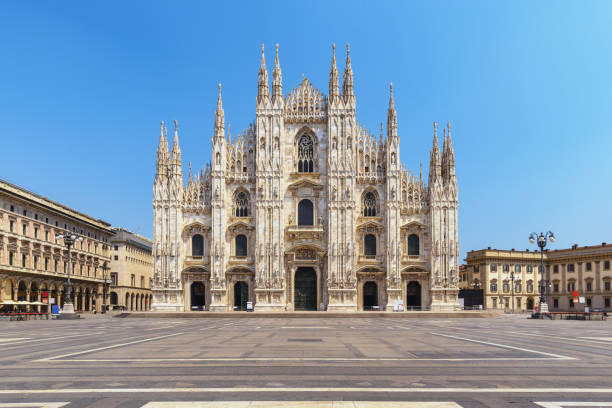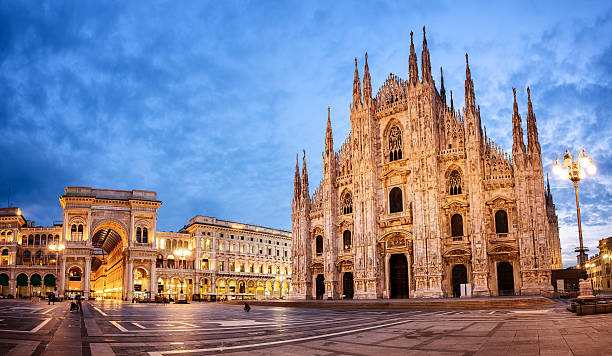The Duomo di Milano: Milan's Majestic Cathedral of Faith, Art, and History
The Duomo di Milano, or the Cathedral of Milan, stands not just as a place of worship but as a symbol of the city’s grandeur, resilience, and artistic brilliance. Located in the heart of Milan, Italy, the Duomo is an iconic landmark that attracts millions of visitors from around the world every year. Its soaring spires, intricate sculptures, and stunning facades tell a story that spans centuries—a tale of political ambition, artistic triumph, and a deep-rooted faith that has shaped the identity of one of Italy’s most important cities.

This majestic cathedral is a masterpiece of Gothic architecture, the result of an extraordinary collaboration of visionaries, architects, artists, and craftsmen. With its history stretching over 600 years, the Duomo is not just the most important religious structure in Milan but also one of the largest and most stunning churches in the world. It represents a testament to human determination, creative genius, and spiritual devotion, where each stone tells a story, and each detail speaks of the devotion to a higher calling.
A Glimpse into History: The Beginnings of the Duomo
The history of the Duomo di Milano dates back to the late 14th century, in the year 1386, when the then Duke of Milan, Gian Galeazzo Visconti, decided to build a new cathedral in the city. The ambition behind the project was immense, with the desire to create a cathedral that would rival the great churches of Europe. The construction was seen as an expression of Milan’s wealth, power, and importance within Italy, as well as a symbol of the Visconti family’s political dominance.
Before the Duomo, Milan had a modest church, the Basilica of Saint Tecla, but the growing city demanded a new, grander place of worship. The Visconti family envisioned a cathedral that would not only be a religious center but a cultural beacon. They envisioned a structure that would project Milan’s newfound prominence on the European stage.
The initial design of the cathedral was heavily influenced by French Gothic architecture. French Gothic cathedrals, with their lofty spires and expansive facades, inspired the architects who first began work on the Duomo. Construction began in 1386, with the foundation stone laid by Archbishop Antonio da Saluzzo. At this point, Milan was under the rule of the Visconti family, and the cathedral was to be a major monument of their reign.
However, the construction of the Duomo would prove to be a project of unprecedented scale, both in ambition and time. What was supposed to be a relatively straightforward project would stretch over six centuries, with various stops and starts along the way, thanks to wars, financial issues, and changes in political power.

Gothic Architecture at its Finest
The Duomo di Milano is one of the finest examples of Gothic architecture in Europe. The building's soaring height, intricate details, and immense size are hallmarks of the Gothic style, which developed in France during the 12th century and spread across Europe in the following centuries. It is the third-largest cathedral in Europe, after St. Peter’s Basilica in Rome and the Cathedral of Seville in Spain.
One of the most striking features of the Duomo is its facade. The cathedral is constructed primarily from pink-hued marble, sourced from quarries in the nearby region of Candoglia. The use of this particular marble gives the building a delicate yet monumental appearance. The facade is adorned with numerous spires, statues, and intricate carvings, many of which are dedicated to biblical figures, saints, and religious motifs. The facade stretches 158 meters in width, making it one of the largest in the world.
Atop the cathedral rises a network of 135 spires that pierce the Milanese sky. These spires, adorned with intricate stone carvings, are one of the most iconic features of the Duomo’s design. The most famous of these spires is the Madonnina, a gilded statue of the Virgin Mary that stands proudly at the highest point of the cathedral. The Madonnina, which stands at 108 meters, is not only a symbol of the Duomo but also of Milan itself. It is said that the statue's height was designed to be taller than any other structure in Milan at the time, as a reminder of the city’s devotion to God.
The cathedral’s interior is equally stunning. Visitors who step inside are greeted by a vast, luminous space, with soaring arches and an awe-inspiring sense of height. The nave, which is the central part of the church, is flanked by two aisles, with numerous chapels along the sides. The interior of the Duomo is decorated with beautiful stained glass windows that depict scenes from the Bible and the lives of saints. These windows fill the interior with a colorful light, creating an ethereal atmosphere that enhances the sense of spirituality within the cathedral.
The Duomo is also home to a remarkable collection of art and relics, many of which were added over the centuries. The cathedral’s altar is adorned with statues and sculptures, while the floor is covered in intricate mosaics. The combination of these elements creates a space that is both grand and sacred.
Construction Through the Ages: The Evolution of the Duomo
While the foundation of the Duomo was laid in 1386, the cathedral’s construction was far from a straightforward affair. The project saw numerous architects and designers come and go, each adding their own vision to the structure. The cathedral's construction proceeded in phases, each marked by changes in architectural style, financial challenges, and the political landscape of Milan.
By the 15th century, the cathedral had reached its first major milestone: the completion of the apse and the start of the construction of the great central nave. In 1481, under the leadership of the architect and sculptor Francesco di Giorgio Martini, work began on the construction of the church’s central dome. This was a key moment in the cathedral’s history, as the dome would later become one of the most defining features of the building.
In the 16th century, the Duomo was further enriched with artistic and architectural elements. One of the most important additions during this time was the creation of the cathedral’s famous “Duomo Museum,” which houses many of the works of art and relics that have been part of the cathedral for centuries. During this period, the cathedral’s facade was also enhanced with new sculptures and carvings that depicted biblical figures and saints.
The Duomo di Milano was finally completed in 1965, more than 600 years after its construction began. The completion of the cathedral was a momentous occasion, marking the end of a long and often arduous journey. The final additions, including the intricate spires and statues that adorn the cathedral, were completed in the mid-19th century under the guidance of architect Giuseppe Piermarini, who oversaw the final stages of construction.
Artistic Marvels: The Beauty Within the Duomo
The Duomo di Milano is not only an architectural masterpiece but also an artistic one. The cathedral is home to an incredible collection of artworks, sculptures, and religious relics that span several centuries. Many of these works have been commissioned by powerful patrons throughout the history of Milan, and they reflect the artistic styles of different periods, from the Renaissance to Baroque to Neoclassical.
One of the most famous works of art housed in the Duomo is the stunning stained glass windows that line the nave and the apse. These windows were created between the 15th and 18th centuries and are some of the finest examples of Gothic stained glass in the world. The windows depict scenes from the Bible, as well as the lives of saints, and their intricate colors and designs create a stunning effect when sunlight streams through them.
In addition to the stained glass, the Duomo is home to a number of sculptures and paintings that add to its beauty. One of the most striking sculptures is the statue of Saint Bartholomew, which can be found in the Duomo’s museum. The statue, created by the artist Marco d'Agrate in the 16th century, is a dramatic and powerful depiction of the saint.
Cultural Significance: A Symbol of Milan
Beyond its architectural and artistic splendor, the Duomo di Milano holds deep cultural and historical significance for the city of Milan and its people. For centuries, the cathedral has been at the heart of Milan’s religious life, serving as the site of countless Masses, ceremonies, and important events. It is a symbol of Milan’s faith, resilience, and identity.
The Duomo is also a symbol of Milan’s artistic and architectural achievements. It represents the city’s long-standing devotion to the arts, and its intricate details reflect the talents of some of the greatest architects, sculptors, and artists in history.
In modern times, the Duomo continues to play a significant role in the cultural and spiritual life of Milan. It remains a site for major religious celebrations, including Christmas Mass and Easter services, as well as national holidays. The cathedral is also a popular destination for tourists, who come from around the world to admire its beauty and learn about its fascinating history.
Visiting the Duomo: A Journey Through Time
Today, the Duomo di Milano is not only a place of worship but also a major tourist attraction. Visitors can explore the cathedral’s interior, marvel at its stunning stained glass windows, and climb to the top of the cathedral’s rooftop for panoramic views of Milan and beyond. The rooftop is accessible by both stairs and an elevator, and it offers a unique perspective of the city’s skyline and the cathedral’s spires.
For those with a keen interest in history, a visit to the Duomo Museum provides further insight into the cathedral’s construction, its artistic treasures, and its religious significance. The museum houses a collection of artifacts, sculptures, and religious relics, many of which were part of the cathedral throughout its long history.
The Duomo di Milano remains one of Italy’s greatest landmarks, a testament to the enduring power of faith, art, and human determination. Its towering spires and ornate facade will continue to inspire awe and admiration for generations to come.
Photo from iStock
0 Comment to "The Duomo di Milano: An Architectural Marvel in Milan, Italy"
Post a Comment